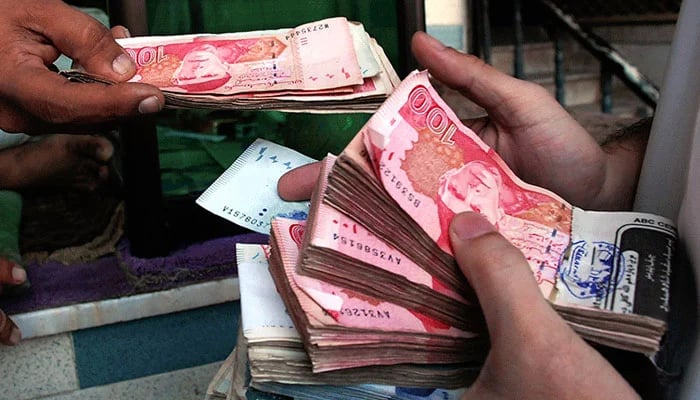Tax collection gap stands at whopping Rs5.8tr in Pakistan
The highest tax-evasion exists in the Sales Tax, and as per some estimates, it could go up to Rs2.9 trillion on annual basis
ISLAMABAD: Pakistan faces a whopping tax-evasion (tax compliance gap) of around Rs5.8 trillion annually, making 6.9 percent of GDP. The evasion on account of POL products is estimated to be Rs996 billion caused by smuggling and other means.
According to a presentation given to Prime Minister Shehbaz Sharif and Special Investment Facilitation Council (SIFC), the tax-evasion (revenue gap) was estimated to be around Rs5.8 trillion on an annual basis on the basis of fiscal year data of 2022-23.
The participants were told that oil was allegedly being smuggled into Pakistan through Iran and other border areas.
The retail sector evasion has been estimated at Rs888 billion, transport sector Rs562 billion, independent power producers (IPPs) Rs498 billion, smuggled-prone items Rs355 billion, exports Rs342 billion and real estate Rs148 billion on annual basis. In the category of ‘others’, the evasion is estimated at Rs1.607 trillion annually.
The highest tax-evasion exists in the Sales Tax, and as per some estimates, it could go up to Rs2.9 trillion on annual basis. The customs gap is estimated at around Rs0.6 trillion (Rs600 billion) on annual basis, including under-invoicing and smuggling.
On the other hand, the IMF has analysed in its Diagnostic Report that the policy level tax gap was not on much higher side and it could go up to maximum 12.9 percent of the GDP.
The presentation — given to the premier and SIFC —also analysed how the compliance gap surfaced between the total revenues and expenditures. The federal tax revenues stood at 9.1 percent of GDP, while the federal non-tax revenue was at 1.2 percent of GDP.
The contribution of provincial taxes to the GDP hovered around 1 percent of GDP. The total revenues stood at 11.4 percent of GDP.
On the expenditure front, the federal expenditure to the GDP stood at 12.9 percent, while the provincial expenditure to the GDP stood at around 6.1 percent, so the total expenditure jacked up to 19 percent of the GDP. There is a gap of 7.6 percent of GDP between the total revenues and expenditures of the country. According to the presentation, tax compliance alone could plug leakages, injecting 5.8 percent of the GDP into the national kitty on annual basis.
This tax-evasion, also called fiscal gap or fiscal deficit, is financed through borrowing from the domestic and external avenues, thus, plunging the country into a debt trap, an independent economist told this reporter.
Keeping in view the grim fiscal position, the government is considering restructuring the FBR through the Federal Policy Board, separation of Tax Policy Office, joint valuations, separation of Customs and Inland Revenues, collaboration with Nadra, PRAL restructuring, digital invoicing, SWAPS, Tajir Dost Retailers Scheme, documentation law and modern governance structure and oversight boards.
-
 'Percy Jackson' Star Feels Relieved After Season Two Finale
'Percy Jackson' Star Feels Relieved After Season Two Finale -
 Jelly Roll Reveals How Weight Loss Changed Him As A Dad: 'Whole Different Human'
Jelly Roll Reveals How Weight Loss Changed Him As A Dad: 'Whole Different Human' -
 Prince Harry Gets Emotional During Trial: Here's Why
Prince Harry Gets Emotional During Trial: Here's Why -
 Queen Camilla Supports Charity's Work On Cancer With Latest Visit
Queen Camilla Supports Charity's Work On Cancer With Latest Visit -
 Dove Cameron Opens Up About Her Latest Gig Alongside Avan Jogia
Dove Cameron Opens Up About Her Latest Gig Alongside Avan Jogia -
 Petition Against Blake Lively PGA Letter Gains Traction After Texts With Taylor Swift Revealed
Petition Against Blake Lively PGA Letter Gains Traction After Texts With Taylor Swift Revealed -
 Netflix Revises Warner Bros. Deal To $83 Billion: All-cash Offer
Netflix Revises Warner Bros. Deal To $83 Billion: All-cash Offer -
 Prince Harry Mentions Ex-girlfriend Chelsy Davy In UK Court
Prince Harry Mentions Ex-girlfriend Chelsy Davy In UK Court -
 David, Victoria Beckham 'quietly' Consulting Advisers After Brooklyn Remarks: 'Weighing Every Move'
David, Victoria Beckham 'quietly' Consulting Advisers After Brooklyn Remarks: 'Weighing Every Move' -
 Meta's New AI Team Delivered First Key Models
Meta's New AI Team Delivered First Key Models -
 Prince Harry Defends Friends In London Court
Prince Harry Defends Friends In London Court -
 AI May Replace Researchers Before Engineers Or Sales
AI May Replace Researchers Before Engineers Or Sales -
 Christina Haack Goes On Romantic Getaway: See With Whom
Christina Haack Goes On Romantic Getaway: See With Whom -
 Consumers Spend More On AI And Utility Apps Than Mobile Games: Report
Consumers Spend More On AI And Utility Apps Than Mobile Games: Report -
 Aircraft Tragedy: Missing Tourist Helicopter Found Near Japan Volcano Crater
Aircraft Tragedy: Missing Tourist Helicopter Found Near Japan Volcano Crater -
 Taylor Swift Lands In Trouble After Blake Lively Texts Unsealed
Taylor Swift Lands In Trouble After Blake Lively Texts Unsealed




